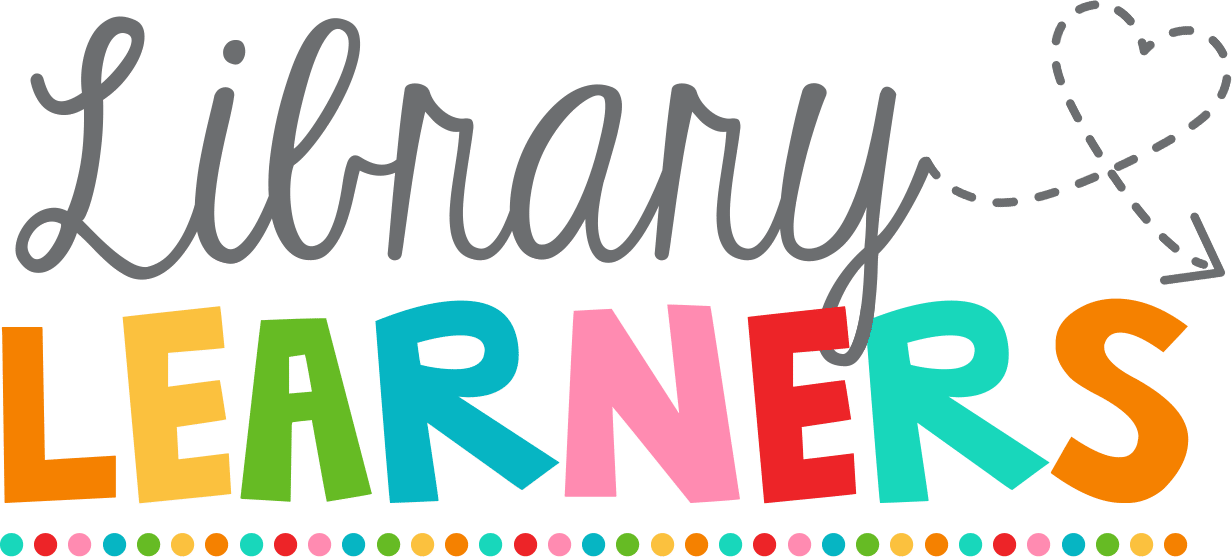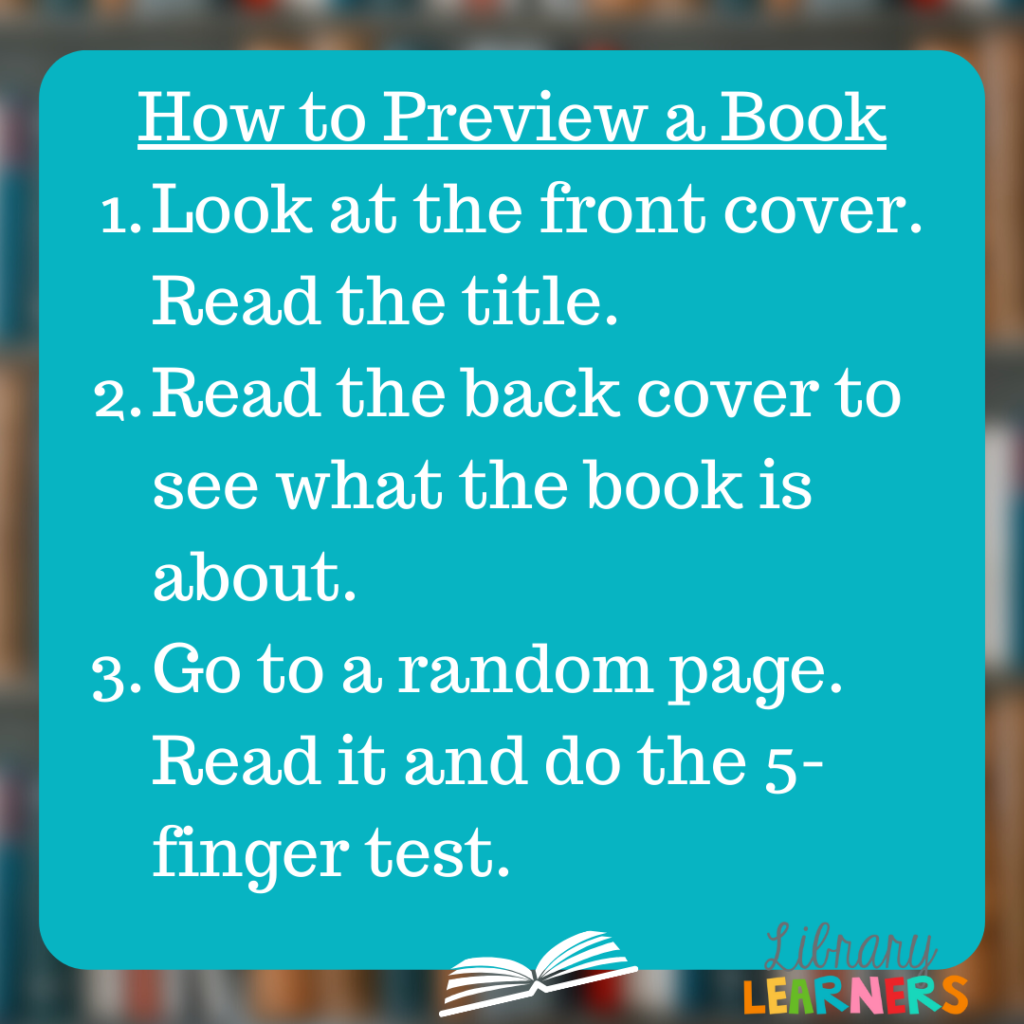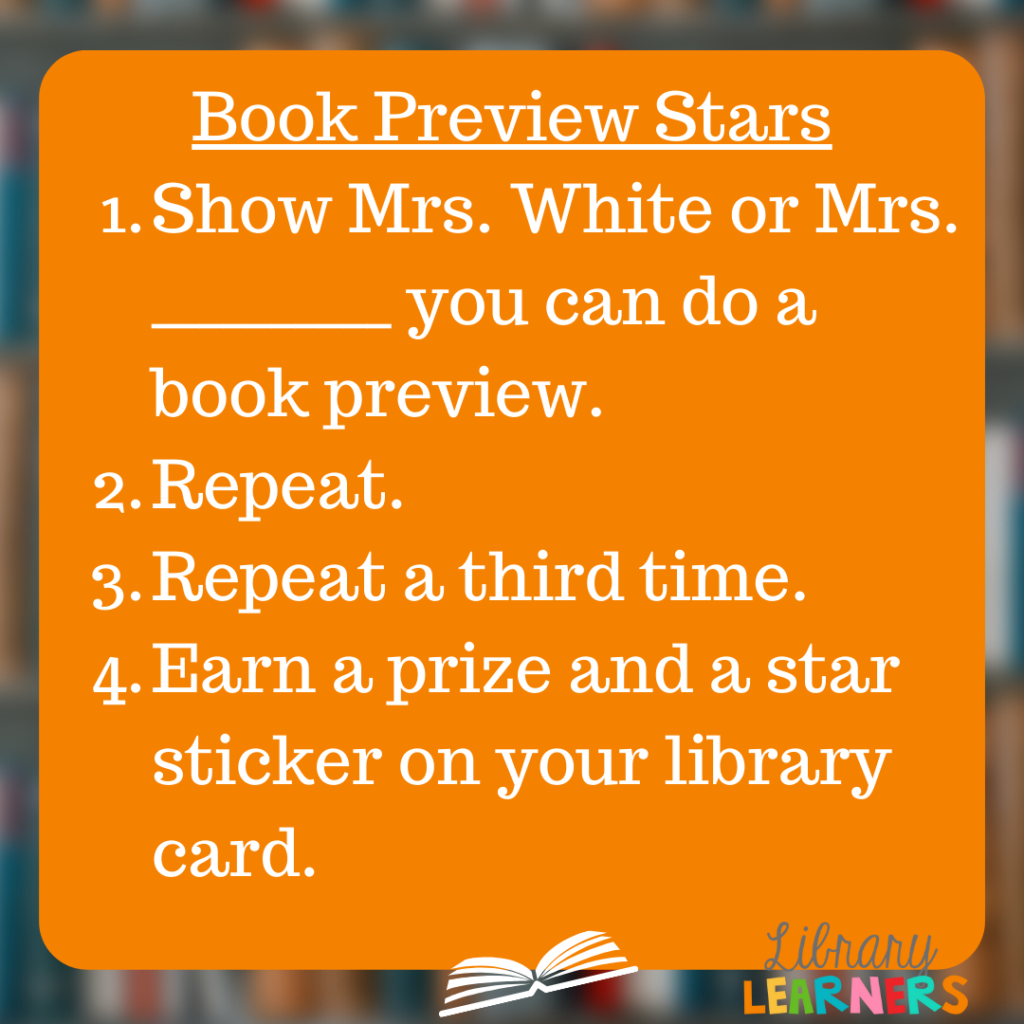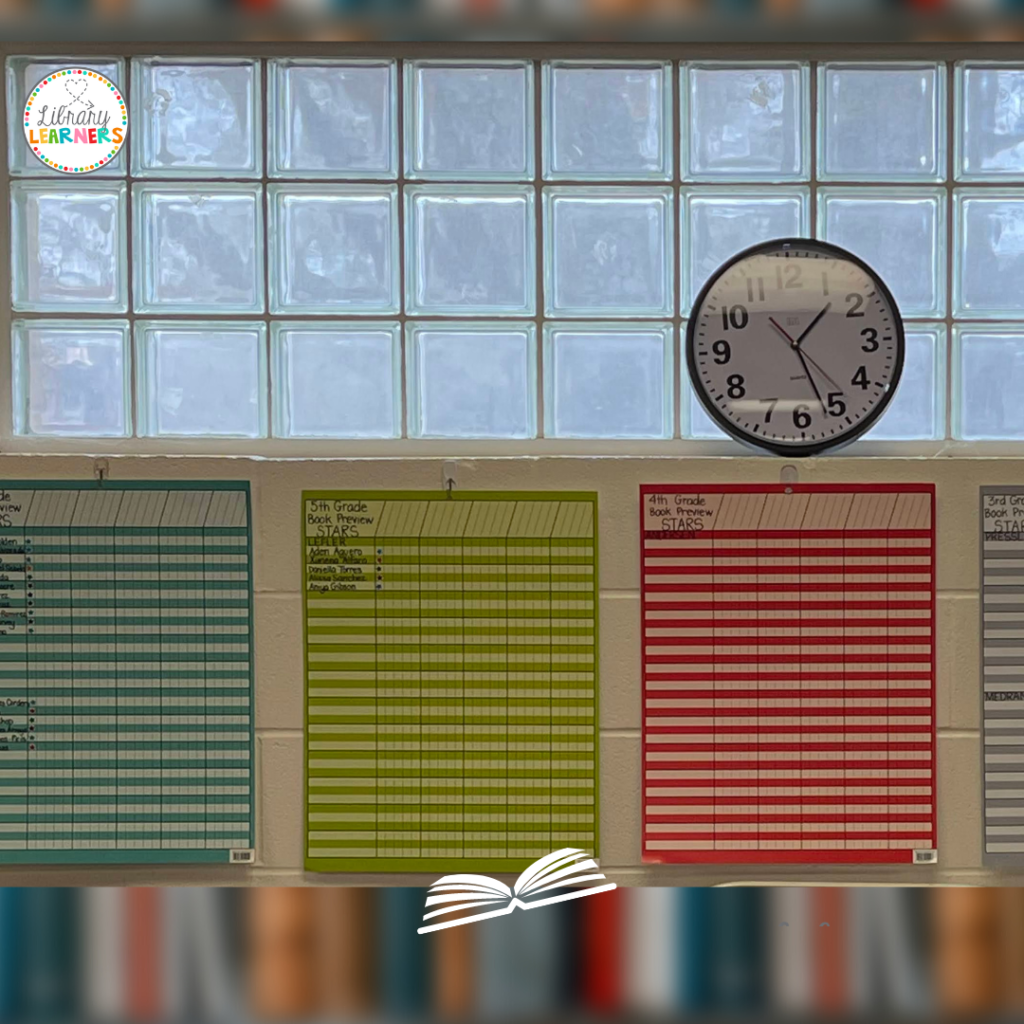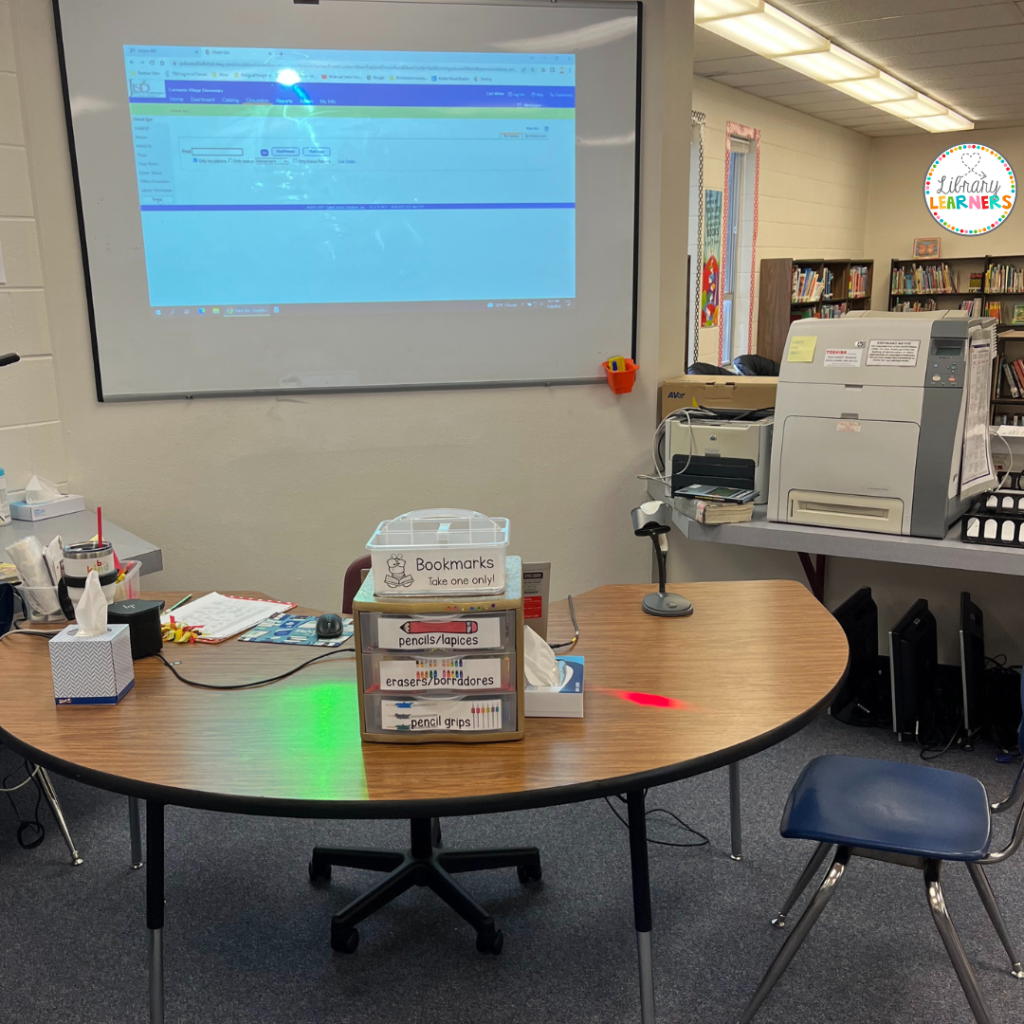Preview Your Books: My Favorite of all Library Lessons
What are your favorite library lessons for your elementary students? My best library lesson ever was having our students preview their library books by reading to me. I saw increased reading comprehension, more joy in books, more reading progress, and a calmer library atmosphere. Let me tell you step by step how this unfolded.
Preview Your Library Books
The fifth grade reading teacher at my last school required her students to preview their library books before they checked them out. As I observed this happening, I realized that this would be an excellent practice for third and fourth grade students as well. I had no idea of the impact this library lesson would have.
The steps she taught them for previewing library books are in the graphic on the left. Since the fifth grade students were already trained, we spent two class periods having the 5th graders record a video of themselves doing a book preview, using the app formerly known as Flipgrid.
If you’ve been an educator for more than a minute, you know that students would rather listen to instructions from a peer than from a teacher. Knowing that, if I was starting this lesson from scratch, I would still teach it to the 5th graders first, and have them create instructions for the younger students.
Third and Fourth Grade Library Lessons
To teach this lesson to third and fourth grade students, I first reviewed the above three steps with the students, then I showed a couple of stellar student book preview videos on the large projection screen. (They paid very close attention to everything the fifth graders said!) I projected the join code for the Flipgrid the 5th graders had created. They then spent an entire class period (after book check-out) watching videos created by the cool 5th grade students, and those videos were available for them to watch for the rest of the school year on their Chromebooks.
The Incentive Plan
I chose to reward students after they had completed 3 book previews with myself or their classroom teacher, who stayed in the library during our class time. I bought scented pencils from Geddes as the prize for completing 3 previews (with either me, the classroom teacher, or a combination of both). I also added one of these star stickers from Amazon to their library cards, so that I could see at a glance that they had completed the challenge. If the line to preview got really long, I would deputize one of these students to supervise book check-out so that I could listen to more book previews.
I used these incentive chart posters from Amazon to track book previews as they were completed. Yes, it took a little time to add all the student names to the charts, but it was definitely worth it! I had the ugliest cinderblock walls, but I was able to use Command hooks to hang the charts on our library wall, right next to the horseshoe table that I used for a teaching station and check-out desk.
Here’s a look at my horseshoe table. I had a supply caddy where I could store the star stickers, extra library cards, pencils and pens, and the scented pencil prizes. I had the treasure box that I use to reward regular library book returns. I also had room for my laptop and scanner (for book check-out) and for the incentive chart posters as I checked off completed previews. I had a chair for the student who was previewing their book with me. It was a busy space, but I often had one or two students who liked to stand around the table and direct traffic.
What Did a Book Preview Look Like and Sound Like?
For a book preview, a student would sit down and preview ONE BOOK with me (fiction, non-fiction, picture book, graphic novel, whatever he chose). He would read the title and tell me about the cover illustration and the blurb on the back and why he had chosen that book. He would then read one page aloud to me. If the student was reading smoothly, I would simply say, “that seems like a great book choice for you. Thanks for previewing it with me! I loved listening to you read!”
If the reading was NOT smooth, if there were many hesitations and misread words, I would ask, “Can you tell me what happened on that page?” If they could not tell me what happened or it seemed like they were just guessing, I would say, “This book sounds like it’s going to be a lot of work for you to read. You can still check it out, but let’s go find another book about _______ that might be more fun and less work.”
We would then repeat the process with the second book that we chose together, and I would say something like, “Wow! You’re reading that so smoothly! Can you hear how well you’re doing?”
For example, if they had chosen a 500-page Chris D’Lacey dragon book that they were struggling to read, we would walk over to the fantasy section and choose a shorter dragon book, like one from the Dragon Slayers Academy series. They would check out BOTH books, so that they would have the opportunity to compare the reading experiences. I would always try to find an alternate book in the same genre, about a similar subject, but on a lower reading level.
Or, I might ask, “How did that reading feel to you? Was it easy and fun? Or was it hard work?” Students need A LOT of practice hearing themselves read and hearing the difference between fluent reading and struggling. We cannot assume that this is happening for every student in every classroom.
I always thanked each student for reading to me, and showed my appreciation for them taking the time to share their book with me. Always. These became very special times for both the students and myself, as we shared reading joy together.
What Did a Book Preview NOT Sound Like?
During these library lessons, I never spoke about reading levels. I never told a student they could NOT check out the book they had chosen. I did not have any students read aloud to a group; they only read to me or their classroom teacher.
I had the same positive reaction for a student who read an Elephant and Piggie book fluently as I did for students reading lengthy novels. I celebrated every reader who previewed with me.
What Surprised Me About These Library Lessons
I was teaching at a dual language, Title I elementary school, and some of my students read primarily in Spanish. I speak very little Spanish, despite the best efforts of our custodian to teach me. I simply had those students read to me in Spanish, and even though I couldn’t translate the words, I could hear whether they were reading smoothly or haltingly. We made it work.
Some of the students started calling these “interviews,” instead of previews, and that made complete sense. They were interviewing the book to see if it was right for the job!
Our students loved these library lessons and did not want to stop after they had earned their prize! I continued to give them stickers on the incentive chart posters, but I think that they really enjoyed the cozy reading experience and their growing confidence.
Our teachers loved these library lessons, even though it required their participation, because we could ALL see the growth as students were checking out books they could actually read AND could enjoy reading.
Students need to be explicitly and repeatedly taught how to choose a book that they will enjoy reading. We can’t count on the classroom teacher to teach these lessons, and we can’t teach one or two library lessons per year on this topic and call it done. That’s what I had been doing in the past, and it just wasn’t working.
The Calm Library Atmosphere
After a couple of months, our third, fourth, and fifth grade classes were fully immersed in the reading preview routine. All students were either searching for a book to preview, waiting in line to preview and check-out, or reading the book they had previewed. When a student got to the front of the line, they would tell me if they had previewed with their teacher. I would glance over at the teacher for a thumbs up, and we’d scan that barcode and mark the chart.
There was no time to waste with off-task behavior. Students received positive attention for reading books with me or their teacher, and students helped each other find books on the shelves. They found meaning in their library tasks.
I scheduled our research projects toward the end of the school year, so that we had lots of practice previewing books before we broke that routine and worked on different skills.
Your Turn
Do you take library time to do book previews with students? I’d love to hear in a comment how you’ve implemented book previews and what you do differently.
Save this post for later with Pinterest!
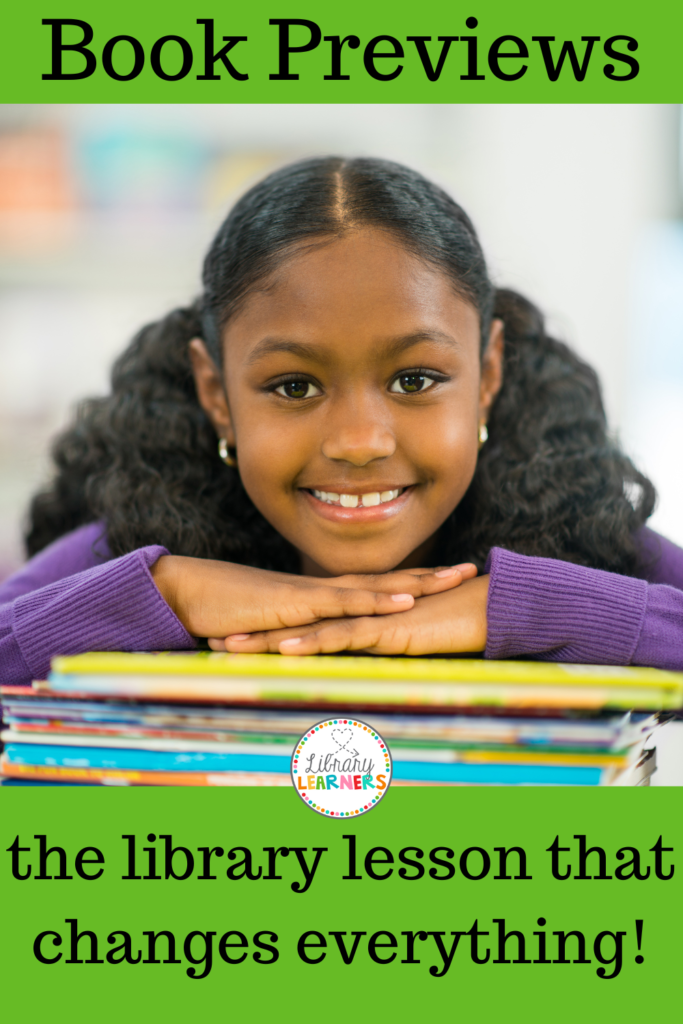
Happy reading!
